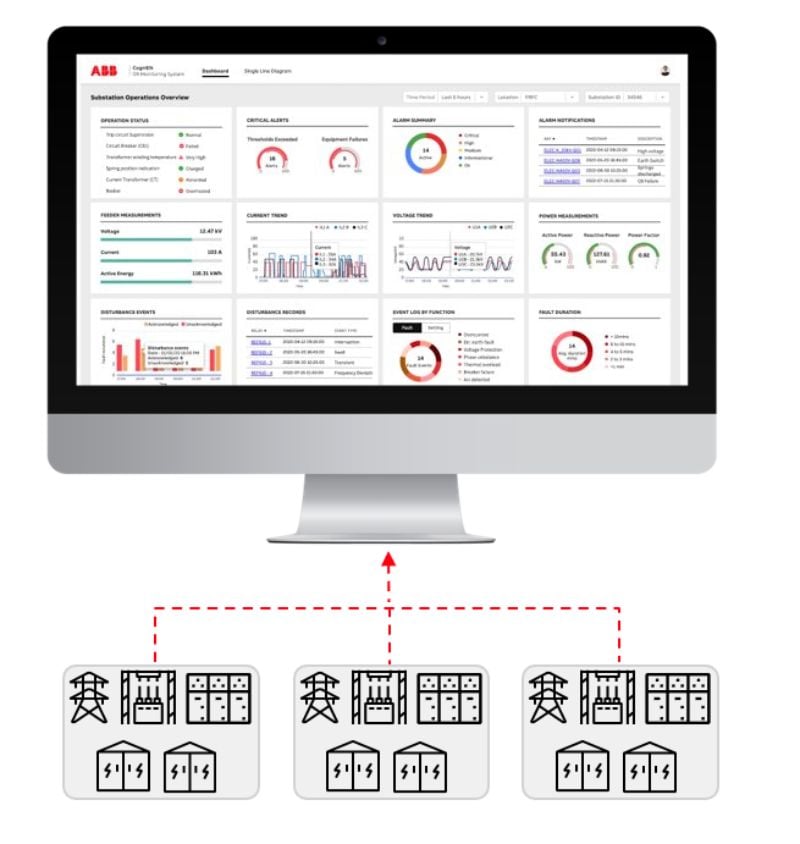ABB Launches Electrical Asset Monitoring Platform
ABB is piloting its new cloud-based asset monitoring platform for cognitive electrical networks used in renewable energy infrastructure, data centers, and EV charging applications.
Switzerland-based electrical equipment giant ABB has introduced a performance monitoring product called “CogniEN” for low- and medium-voltage electrical equipment. The software will initially be rolled out in Europe and the United States, serving renewable energy applications, electric vehicle charging systems, data centers, and other connected devices.
ABB’s CogniEN software. Image used courtesy of ABB Electrification
CogniEN is particularly suited for cognitive electrical networks utilizing data intelligence. Like other remote asset performance tools, CogniEN allows operators to identify problems with their electrical installations and send maintenance teams faster than previously possible without 24/7 monitoring.
Hosted on Amazon Web Services, the cloud-based service is billed as “vendor-agnostic.” It can pull data from devices in the ABB ecosystem or third-party equipment providers and upload it into the cloud so that operators can access the latest performance data. CogniEN can be used with substation automation equipment, power plants and microgrids, EV chargers and switchgear, and battery energy storage systems.
How CogniEN Works
CogniEN can help customers optimize their assets across several sites via predictive analytics. ABB’s press release cited an example of electrical infrastructure owners using time-of-use pricing models with local utilities; in that case, CogniEN can help decide when to store and dispatch energy to/from the grid.
A basic subscription provides raw data access, but customers can order a more advanced setup to detect and predict asset failures before they bring down operations. Users can also scale up the number of devices connected to the software. For instance, renewable energy infrastructure firms can start with one power station and eventually add thousands more, with the platform adjusting accordingly.
CogniEN asset performance monitoring software for utilities, EV and renewable energy infrastructure owners, and other customers. Image used courtesy of ABB Electrification
Electrification Boom Propels Electrical Monitoring Demand
The increasing adoption of grid-connected renewables and EV charging systems raises the demand for power distribution analysis software. Power monitoring and control platforms allow users—such as utilities, EV charging infrastructure operators, or data centers—to improve the efficiency and reliability of their operations and schedule critical maintenance tasks before components fail.
One research report projected the power monitoring and control software market will increase by $3.4 billion from 2022 to 2027. Another report pegged growth at $3.1 billion in 2022 to $5.2 billion in 2028. Both reports (along with others not mentioned here) cite ABB as a leading player in this space. ABB’s Electrification division offers a range of products meeting this area of demand, serving power and distribution customers with digital asset management tools.
ABB has made several recent moves to expand its asset monitoring portfolio. Earlier this year, the company invested in OKTO GRID, a Danish startup developing an asset monitoring platform for transformer infrastructure operators. It also acquired Austrian digital energy optimization/control firm ASKI Energy last October, boosting its advanced energy management software portfolio for smart grids, solar installations, EV chargers, battery energy storage systems, and demand-side management applications.
ABB’s cloud solution for connected electrical systems. Image used courtesy of ABB Electrification
Relatedly, the company posted its first-quarter 2023 earnings, reporting that ABB Electrification’s order intake reached its highest quarterly level in several years. This coincided with growing market demand across all customer segments except residential construction.









